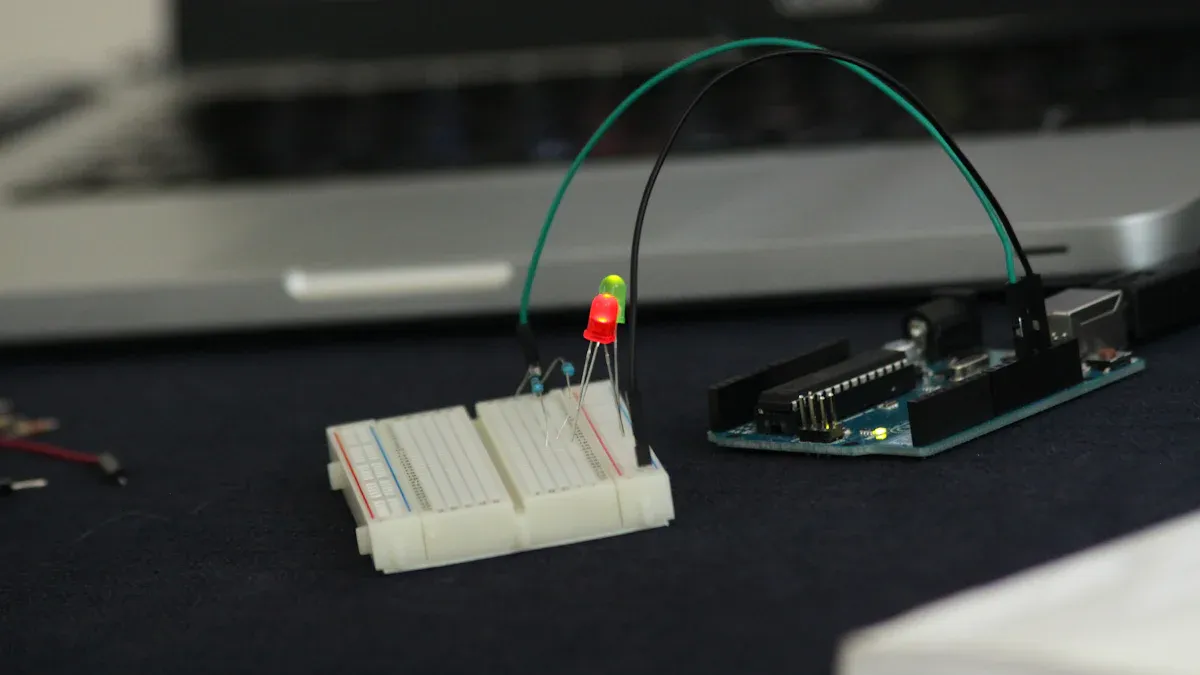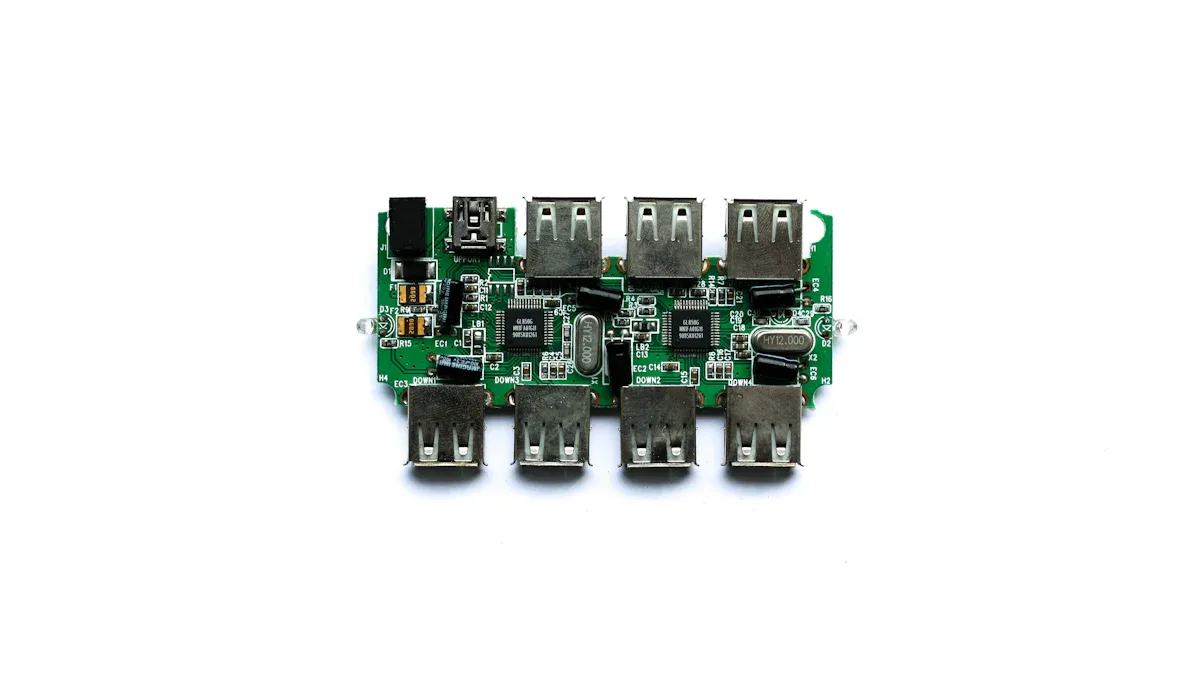OPA4991IPWR Features and Specifications Explained

The OPA4991IPWR is a high-performance operational amplifier designed for applications that demand accuracy and reliability. Engineers value its precision and low noise, which help deliver clean and stable signals. This device also offers versatility, making it suitable for a wide range of electronic circuits. Understanding its features and specifications ensures that users select the right op-amp for their specific needs.
Key Takeaways
The OPA4991IPWR offers high precision and low noise, ensuring accurate and stable signal processing even in harsh environments.
Its rail-to-rail input and output allow the amplifier to handle signals close to supply voltage limits, maximizing dynamic range and design flexibility.
The quad amplifier design combines four independent op-amps in one compact package, saving space and simplifying multi-channel circuit layouts.
This amplifier supports a wide supply voltage range from 2.7 V to 40 V, making it suitable for both low-voltage and high-voltage applications.
Good PCB layout and thermal management are important to maintain the OPA4991IPWR's precision and reliability in demanding systems.
OPA4991IPWR Features
The OPA4991IPWR stands out due to its combination of precision, low noise, rail-to-rail operation, and quad amplifier configuration. These features make it a strong choice for engineers and hobbyists who need reliable and accurate analog signal processing in demanding environments.
Precision
Precision is a defining characteristic of the OPA4991IPWR. This operational amplifier maintains stable performance across a wide temperature range, which is essential for applications that require consistent accuracy. The device uses a CMOS architecture and offers rail-to-rail input and output capability, further supporting precise analog signal processing. The following table summarizes key parameters that contribute to its precision:
Parameter | Value |
|---|---|
-40°C to 125°C | |
Typical Offset Voltage Drift | 0.3 µV/°C |
Maximum Offset Voltage (25°C) | 0.83 mV |
Architecture | CMOS |
Input/Output Capability | Rail-to-rail |
These specifications show that the OPA4991IPWR minimizes offset voltage changes, even as temperatures fluctuate. This stability ensures accurate measurements and signal integrity in industrial, automotive, and instrumentation systems.
Low Noise
Noise performance is critical in precision analog applications. The OPA4991IPWR delivers a low noise density of 10.8 nV/√Hz at 1 kHz, which helps maintain clean signal paths and reduces unwanted interference. This low noise level makes the device suitable for high-speed communication systems, data acquisition, broadband signal processing, and precision instrumentation. Engineers often select this amplifier for its ability to deliver both low power consumption and low noise, which is especially important in demanding industrial and automotive environments.
Tip: Low noise amplifiers like the OPA4991IPWR help improve the accuracy of sensitive measurements and enhance the performance of sensor interfaces.
Rail-to-Rail Operation
The OPA4991IPWR features true rail-to-rail input and output operation. This capability allows the amplifier to process signals that are very close to the supply voltage limits, maximizing dynamic range and flexibility in circuit design. Key characteristics include:
Input common-mode voltage range extends about 100 mV beyond each supply rail.
N-channel input pair operates from (V+) - 1 V to 100 mV above the positive supply.
P-channel input pair operates from 100 mV below the negative supply to about (V+) - 2 V.
Output voltage swing headroom is typically within ±25 mV of the supply rails.
These features confirm that the OPA4991IPWR can handle signals near both the positive and negative supply rails, which is valuable for low-voltage and battery-powered systems.
Quad Amplifier
The OPA4991IPWR integrates four independent operational amplifiers into a single compact TSSOP-14 package. This quad configuration provides several advantages:
Saves board space by consolidating four amplifiers into one device.
Reduces component count and simplifies routing, which enhances reliability.
Supports efficient multi-channel designs, ideal for sensor signal conditioning, data acquisition, and active filtering.
Offers robust performance in space-constrained and harsh environments, such as industrial and automotive systems.
The quad amplifier design enables engineers to build high-density, multi-channel circuits without sacrificing precision or noise performance. This integration streamlines system design and supports reliable operation in demanding applications.
Specifications

Electrical
Engineers often look for operational amplifiers with strong electrical performance. The OPA4991IPWR delivers several key specifications that support high-speed and precision applications. The following table highlights important electrical characteristics:
Specification | Value |
|---|---|
Supply Voltage Range (min) | 2.7 V |
Supply Voltage Range (max) | 40 V |
Input Bias Current | 10 pA |
Quiescent Current per Channel | 0.56 mA (560 µA) |
Slew Rate (typical) | 21 V/µs |
The OPA4991IPWR offers a wide supply voltage range, which allows designers to use it in both low-voltage and high-voltage systems. Its low input bias current helps maintain signal integrity, especially in sensor applications. The typical slew rate of 21 V/µs enables fast response to changing signals, making this amplifier suitable for high-speed data acquisition and communication circuits.
The gain bandwidth product (GBW) is another important specification. The OPA4991IPWR features a GBW of 100 MHz. This value is much higher than similar operational amplifiers, such as the OPA4990QDRQ1, which has a GBW of 4.5 MHz. The high GBW means the OPA4991IPWR can handle rapid signal changes and support high-frequency designs. Designers often choose this device for applications that require both speed and accuracy.
Other notable electrical specifications include low offset voltage and low noise. These features help maintain precise signal processing and reduce errors in measurement systems. The combination of low quiescent current and high performance makes the OPA4991IPWR a strong choice for battery-powered and portable devices.
Note: High gain bandwidth and low noise help improve signal quality in audio, medical, and industrial systems.
Package
The OPA4991IPWR comes in a compact TSSOP-14 package. This surface-mount package measures approximately 5 mm by 3 mm, with a width of 4.40 mm (0.173 inches). The small size allows engineers to save board space and build dense circuits. The TSSOP-14 package supports automated assembly and is suitable for modern manufacturing processes.
Designers often select the OPA4991IPWR for applications where space is limited. The quad amplifier configuration inside the package further reduces component count and simplifies layout. The surface-mount design ensures reliable connections and supports high-volume production.
Environmental
The OPA4991IPWR is built to operate in harsh environments. Its wide operating temperature range extends from -40°C to 125°C. This range allows the amplifier to function reliably in industrial, automotive, and outdoor systems. The device also includes 100% ESD anti-static protection in its packaging, which helps prevent damage during handling and assembly.
Parameter | Rating/Description |
|---|---|
Operating Temperature | -40°C to 125°C |
ESD Protection | Packaging includes 100% ESD anti-static protection |
The OPA4991IPWR maintains stable performance even when exposed to extreme temperatures. Its robust electrical characteristics and packaging make it suitable for sensor signal conditioning, process control, and medical equipment. Compared to other operational amplifiers, the OPA4991IPWR stands out for its combination of wide temperature tolerance, low offset voltage, and reliable operation in demanding conditions.
Tip: Devices with wide temperature ranges and ESD protection are ideal for industrial and automotive projects.
Applications

Typical Uses
Engineers often select the OPA4991IPWR for projects that require high accuracy and low noise. This operational amplifier supports a wide range of analog circuit designs. Common application areas include:
Sensor signal conditioning
Active filtering
Industrial process control
Medical equipment
Data acquisition systems
High-speed communication systems
Broadband signal processing
Audio equipment
Test and measurement instruments
Medical devices
These uses highlight the amplifier’s versatility. For example, in sensor signal conditioning, the device helps convert weak sensor signals into strong, accurate outputs. In audio equipment, it delivers clear sound by reducing unwanted noise. Industrial process control systems rely on its stable performance to monitor and adjust machinery. Medical devices benefit from its precision, which ensures reliable readings and safe operation.
Note: The OPA4991IPWR’s low offset voltage and high gain bandwidth make it ideal for applications where signal integrity is critical.
Design Tips
Proper integration of the OPA4991IPWR into a printed circuit board (PCB) ensures optimal performance. Engineers should follow several layout considerations to minimize noise and interference:
Refer to the recommended PCB layout from Texas Instruments datasheets.
Place components thoughtfully to reduce parasitic inductance.
Route traces carefully and keep them as short as possible.
Use a solid ground plane to improve signal integrity.
Add shielding or filtering components for better electromagnetic compatibility.
Consider common-mode chokes or ferrite beads to reduce electromagnetic interference.
Plan for thermal management by providing heat sinking and monitoring temperature.
Tip: Good PCB layout practices help maintain the amplifier’s precision and reliability, especially in high-speed or sensitive applications.
These design tips help engineers achieve the best results when using the OPA4991IPWR in demanding environments.
Comparison
Alternatives
Engineers often compare operational amplifiers to find the best fit for their projects. The OPA4991IPWR competes with other quad-channel, low-power op-amps in the market. Price and performance play a big role in the selection process. The table below shows how the OPA4991IPWR compares to a close alternative:
Part Number | Manufacturer | Price (USD) | Description |
|---|---|---|---|
OPA4991IPWR | Texas Instruments | Quad, 40-V, 4.5-MHz, low-power operational amp | |
OPA4991QDYYRQ1 | Texas Instruments | $1.94 | Automotive, quad, 40-V, 4.5-MHz, low-power op amp |
Both options offer similar performance. The OPA4991IPWR provides a slightly lower price, making it attractive for cost-sensitive designs. The automotive-grade OPA4991QDYYRQ1 costs a bit more but meets stricter standards for vehicle use.
Pros and Cons
The OPA4991IPWR stands out for its balance of features. It offers four independent amplifiers in one compact package. This design saves space and reduces the number of parts on a circuit board. The amplifier delivers low noise, low offset voltage, and a wide supply voltage range. These features help engineers build accurate and flexible circuits.
Feature | Description |
|---|---|
Quad Channel | Four op-amps in one package, ideal for multi-channel designs |
Low Noise | Suitable for precision and low-level signal amplification |
Low Offset Voltage | Enhances accuracy in DC applications |
Wide Supply Voltage Range | Operates from 4.5V to 36V, providing design flexibility |
Rail-to-Rail Input/Output | Maximizes dynamic range in low supply voltage applications |
High Slew Rate | Fast response for rapidly changing signals |
Low Quiescent Current | Efficient power use, good for battery-powered devices |
Wide Operating Temp Range | Works from -40°C to 125°C, suitable for harsh environments |
Package | Compact TSSOP-14 for space-saving designs |
Note: The OPA4991IPWR combines high precision, versatility, and low power use. This makes it a strong choice for many applications.
However, some users may need even higher bandwidth or automotive certification. In those cases, alternatives like the OPA4991QDYYRQ1 may be better. The OPA4991IPWR remains a top pick for most precision, low-noise, and space-limited designs.
The OPA4991IPWR offers engineers a unique blend of precision, speed, and efficiency. Its quad-channel design, rail-to-rail input/output, and wide supply voltage range set it apart from other operational amplifiers. The table below highlights its most significant features:
Feature | Benefit |
|---|---|
Quad Channel | Multi-channel applications |
Rail-to-Rail I/O | Maximizes dynamic range |
High Slew Rate | Fast signal response |
Low Offset Voltage | Enhanced accuracy |
Wide Temperature Range | Reliable in harsh environments |
This operational amplifier meets industry standards for demanding tasks in instrumentation, sensor conditioning, and medical equipment. Engineers should consider these strengths when selecting an op-amp for precision and high-speed needs.
FAQ
What is the main advantage of using the OPA4991IPWR in sensor applications?
The OPA4991IPWR provides high precision and low noise. These features help engineers achieve accurate sensor readings. The amplifier also supports stable operation in harsh environments.
Can the OPA4991IPWR operate with both low and high supply voltages?
Yes. The OPA4991IPWR works with supply voltages from 2.7 V to 40 V. This wide range gives designers flexibility for many types of circuits.
Does the OPA4991IPWR support rail-to-rail input and output?
Yes. The OPA4991IPWR offers true rail-to-rail input and output. This feature allows the amplifier to handle signals close to both supply rails, which maximizes dynamic range.
What package type does the OPA4991IPWR use?
Package Type | Pin Count | Size (mm) |
|---|---|---|
TSSOP | 14 | 5 x 3 |
The OPA4991IPWR comes in a compact TSSOP-14 package, which saves board space.
See Also
Key Characteristics And Functions Of IC Audio Signal Processors
A Comprehensive Guide To Communication Chips And Their Operation
Exploring Low Power IoT Chip Tech And Its Practical Uses
How Hotswap Controller Chips Function And Their Main Purposes
The Role Of PLC Components In Industrial Automation Processes
